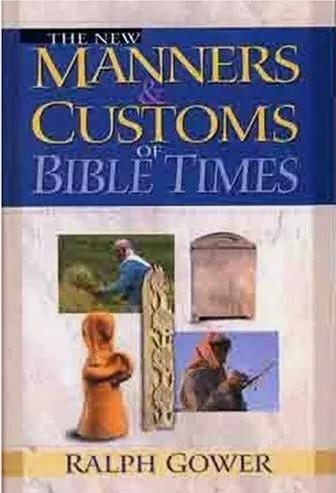The New Manners and Customs of Bible Times
 ISBN: 080245951X
ISBN: 080245951X
Note: The version reviewed is probably the 1987 version. It has a blue and white cover with some pictures on it. The book has been updated several times, probably to keep it “new”.
Ralph Gower has put together a masterpiece. If you want to deepen your understanding of the Bible, there are few works with as many hidden gems as Gower’s has.
There are so many positives to this book that it makes sense to begin with the negatives. The worst thing that can be said about this book is that some of the pictures do not show the kind of detail that the text describes. The reader is left wanting the ability to change the angle of the view of the lens of the camera to get a better idea of subjects like the architectural layout of a certain kind of Biblical-era home. Toward the end of the book, it feels a little like Gower is rushing us through the end of the suggested three weeks of time it takes to thoroughly explore the sites he discusses. Probably, these sites are options he would work into a given tour of Israel depending on how fast or slow the tour in question was.
As for the positives, there are almost too many to list. A better way to discuss some hard-won expertise is to pose some questions that are answered by the book:
- How was salt used in the Holy Temple?
- What word did the Messiah use to calm the stormy waters?
- Why was the above word used?
- What does it mean if you eat a meal together?
- Who was given the honored guest title in the Last Supper setting?
- What was given him (the guest) that conveyed this?
- What were the roles of women in Biblical Society?
- What are notable exceptions to those roles?
- Why was the Samaritan woman at the well at noon?
- What distinguishes a Seer from a “navi”?
- Where did the Sanhedrin re-locate after the Temple was destroyed?
- What was there?
- Why might that be significant?
These are but a handful of issues this book addresses. There are many textual breaks that have full-color pictures that show or reinforce what the text was saying, along with yellow-attention boxes at the end with what are often referred to as “call-out” types of information. Many great nuggets of wisdom can be found in these yellow boxes. Be certain not to skip them or gloss over them if you choose to read this book.
Another interesting perspective Gower offers is why the Pharisees were such a problem during the time of the Messiah. There are certain kinds of realizations present in the discourse that transcend the political and go directly to the spiritual. Often the point is emphasized that the Pharisees were concerned with the law, but why they were so preoccupied is seldom mentioned. Gower makes the differences transparent.
The best thing for the casual reader is probably that the chapters are arranged in a manner of reading that is more bite-sized so that if you happen to be busy during the day with other tasks, you can easily return to where you were last reading without any loss of context. This is reminiscent of a textbook meant to emphasize retention and the form works well in this instance.
It would be interesting to compare more recent copies to this edition to see if any subsequent edits have compromised the book. Revisionism in the publishing industry is a sad fact, and it would be a shame for this book to have been subjected to such myopic procedures. Perhaps if the opportunity presents itself, a follow-up review will be added to this one.
There are many books on the Bible out there. It is simple to do far worse than this one. Looking around on Ebay, it appears to run in the six-dollar range. For the information it has, it six dollars would be well-spent.